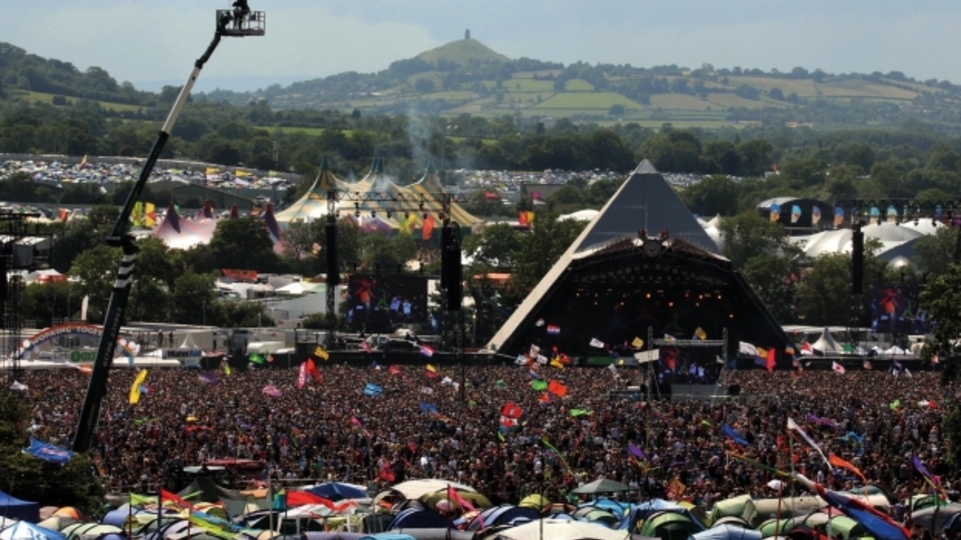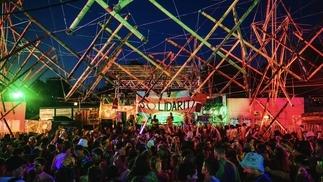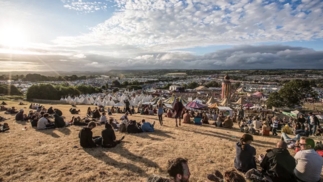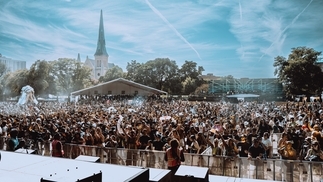REVIEW: GLASTONBURY 2014
New world order

Glastonbury isn't a festival, it's a settlement. Twice the size of Bath, it's more like a refugee camp for society's arty and most liberal than anything you'll see on Escape to the Country. Rather than one festival, Glastonbury is more like five or six — Bestival, Secret Garden Party, Glade, Lovebox and SW4 — all rolled into one.
Such breadth offers something for a lot of us, attracting a diverse selection of people. Glastonbury's tribes, if you will, range from middle-aged backpackers with portable deckchairs to boozy jocks stripping off on first sight of a sun ray (“do you work out, mate?”).
There's also the spiritualists and yoga teachers, real hippies and the other kind (yippies) — yuppies and hipsters (or both, yupsters) — scousers and, of course, shed-loads of ravers (likely to fit into more than one of the above categories).
It's the latter group that's grown in size exponentially over the last 20 years. It wasn't until '95 that Glastonbury formally accepted dance music with a dedicated stage. Prior to that, following the acid house explosion, there were a few unofficial soundsystems. The Glade emerged in '98 — before growing into a festival of its own — and Lost Vagueness — now known as Shangri-La — arose during the early '00s. Dance Village was next, cropping up as a series of stages and tents throughout the mid-'00s, and that was expanded and reborn as Silver Hayes in 2013.
Hence, Glastonbury has really solidified its dance music credentials in recent years, attracting more and more serious clubbers each time. Last summer, following a year off, the hype across our social networks went ballistic. Partly to do with the stunning weather, the birth of Silver Hayes wasn't just a coincidence.
With the Sonic stage — a giant white wafer of a tent with open sides, complete with giant screens — the area's centre piece, this weekend it sees headline performances from Richie Hawtin, Fatboy Slim and Above & Beyond, while throughout the day 4/4 obsessors are treated to big sets from Maya Jane Coles, Hannah Wants, Annie Mac, Gorgon City and Tiga, who crosses into Eats Everything's set after an electric storm interrupts his. An incident which sees us marooned for an hour while music is temporarily down across the whole site.

Opposite is the dance-pioneering BBC Introducing tent, while a stone's throw away is Wow!, a big-top hosting DJ talent like Waze & Odyssey, Seth Troxler & Jamie Jones and Klock & Dettmann at night, and a mocked-up boat party outside during the day.
It's here we see Optimo drop dirty disco and industrial funk in the blazing sun on Thursday, followed by Jackmaster's first Prince tribute of the weekend ('Controversy'); a salute to (never realised) rumours he's appearing at some point as a secret special guest (instead, to our disappointment, we get Kaiser Chiefs opening The Pyramid and, according to some bloke spreading nefarious rumours around the site, Foo Fighters).
Toddla T is also here on Saturday and at the Aus Music takeover on Sunday afternoon, Midland builds a flawless set full of primitive percussion, beatnik house and techno that includes the tear-jerking 'Can't Do Without You' by Caribou mixed skilfully into filtered disco, before Bicep take energy levels up a notch.
James Murphy and 2ManyDJs showcase their coveted Despacio soundsystem in a tent next door and we stumble upon an insanely tight live performance from Brummie tropical pop outfit Troumaca on account of La Pussy Parlure Nouveau, a lavishly decorated boudoir with an enticing name and equally sassy appearance.
Maxxi Soundsystem is playing a secret set over a vintage dress store named Boo-Dior and there's a mosh pit going off to reggae at Greenpeace's Heds Party stage, next to a stack of rusty corrugated iron boxes they call The Blues — and that's just Silver Hayes; a mere percentile of Glastonbury's tireless activity, all happening within a mile of main stage action — the likes of Dolly Parton, Blondie and Arcade Fire at The Pyramid and The Other Stage — enjoying primetime air in people's homes via the BBC all over the country.
Indeed, there's plenty more to see, but even more to miss. While supping a cocktail to Jackmaster (yep, again) doing his best impression of the best wedding DJ ever on Sunday (Prince, Talking Heads, The Smiths etc) at Beat Hotel, we're partially conscious of what's happening elsewhere.
ESG over at The Park Stage — on the other side of the site — (when we do remember) is a muddy trudge too far, while, also regrettably, we do not make Four Tet's experimental future jazz DJ set as it takes longer than expected to get from West Holts to Stonebridge Bar (only half an inch on the map) following John Wizard's leftfield Afrobeat pop live.
Instead, we wander through The Healing Field — where palm readers, spiritual motivators and thespian fops connect with the cosmos — then admire the almost unfathomable girth of the site from the observational point atop of the hill — 117,500 people spread across eight miles of campsite, tents and stages — before heading to the stone circle where we spot Liverpudlian comedian John Bishop hanging out with family.
DJ EZ (Friday) and David Rodigan (Sunday) bring some lighthearted fun at a hydraulic flame-throwing spider known as Arcadia, which makes Bestival's equivalent look like a pond-bothering firefly in comparison. The place is literally ram-jam for Disclosure on Saturday night, where a man in a metal suit, to our horror, is having his head electrocuted inside a cage — don't try this at home, kids! — while a mechanical war horse clunkily saunters by as we happily sip a mojito.
A glance at Harry Styles in a pair of Hunter wellies one minute and a spellbinding live set from Little Dragon at John Peel Stage the next; stories of bassline circuses, rabbit holes and cock-flashing techno trannies at NYC Downlow help reinforce how Glastonbury is not a festival you can plan. Rather than control it, it's better to allow the unpredictable experience lead you.
Inadvertently, we catch a secret, intimate and notably classic set from Fatboy Slim, supported by wife Zoe and friends jumping on an unmade Mancuso mattress beside the decks, again over at Beat Hotel; a chic marquee styled like a Hollywood motel, which inside feels more like 1969 San Francisco than a festival tent in an English field.
After dark, we find ourselves drawn to Shangri-La at the other side of the site, not only as it goes on later than anything else, but because it's the most talked-about area. It's there we encounter Shangri-Hell — made up of fiery structures built out of logs — literally looking like the end scenes of Hellboy. The house and techno resonating within its walls, however, tells a different story as Pete Tong goes b2b with Kölsch, before Jackmaster (no way?!) and Oneman do their Can You Dance? thing live on Radio 1.

Lined by luminously bright, image-mapped boxes and sprawling with hidden walkways scattered with giant skulls and post-apocalyptic motifs, the Shangri-La lay-out is undoubtedly Glastonbury's most ambitiously conceived, nothing short of a masterpiece.
Around the corner at Bloc 9, a crashed subway train suspended mid-air from a building to Spielbergian effect — high-rises towering above and all around us — makes for a high-budget set for an 'end of days' film we're never going to see. The only difference is the packs of partying people crammed within, pushing to the front of stages and queuing for tents and various hidden attractions. Admittedly, the effect is more Judge Dredd than Judge Judy but the sheer amount of people make it tricky to get close to anything.
With ravers penned into a relatively compressed space, congestion is indeed a slight problem, an inevitable drawback from having the perimeter of so many visionary installations walled off — a malaise the open grounds of Silver Hayes don't suffer from at all. However, it's the crammed-in creativity that make this setting so inspiring. And while wider space would allow a better flow of traffic, it would almost certainly impair the intensity of the experience found inside.
What's certain, though, is that, with nothing else really competing for footfall (it's after 2am after all), a bottle neck influx at one of the site's most popular attractions is almost inevitable — and potentially avoidable if other sections of the site are left to continue more stridently for longer.
Unlike any other event we've experienced, Glastonbury is a universe made up of multiple worlds. An escapist macrocosm of culture not only about music, where DJs stay and play a handful of times, and where gourmet ostrich burgers, stone-baked pizzas and pulled pork sandwiches serve as the food of choice instead of shitty noodles or an anaemic burger from a van.
It's a multi-faceted cultural gathering still pretty much untouched by corporatism where what really matters — rather than age, sex, race or class — is that you don't disrupt or disturb the status quo of a 44-year-old establishment with more integrity than probably any other.
Aside from the weather — for all the muddy sludge and impromptu showers — this festival is one you can trust and it requires all the respect it deserves. In a world where our MPs and TV celebrities are more corrupt than many of the world's criminals, we thank our lucky stars above for a subcultural settlement with as much substance as Glastonbury — nowadays a bonafide dance mecca. Go on! Tick it off your bucket list (if you haven't already). You'd be a numpty not to.





